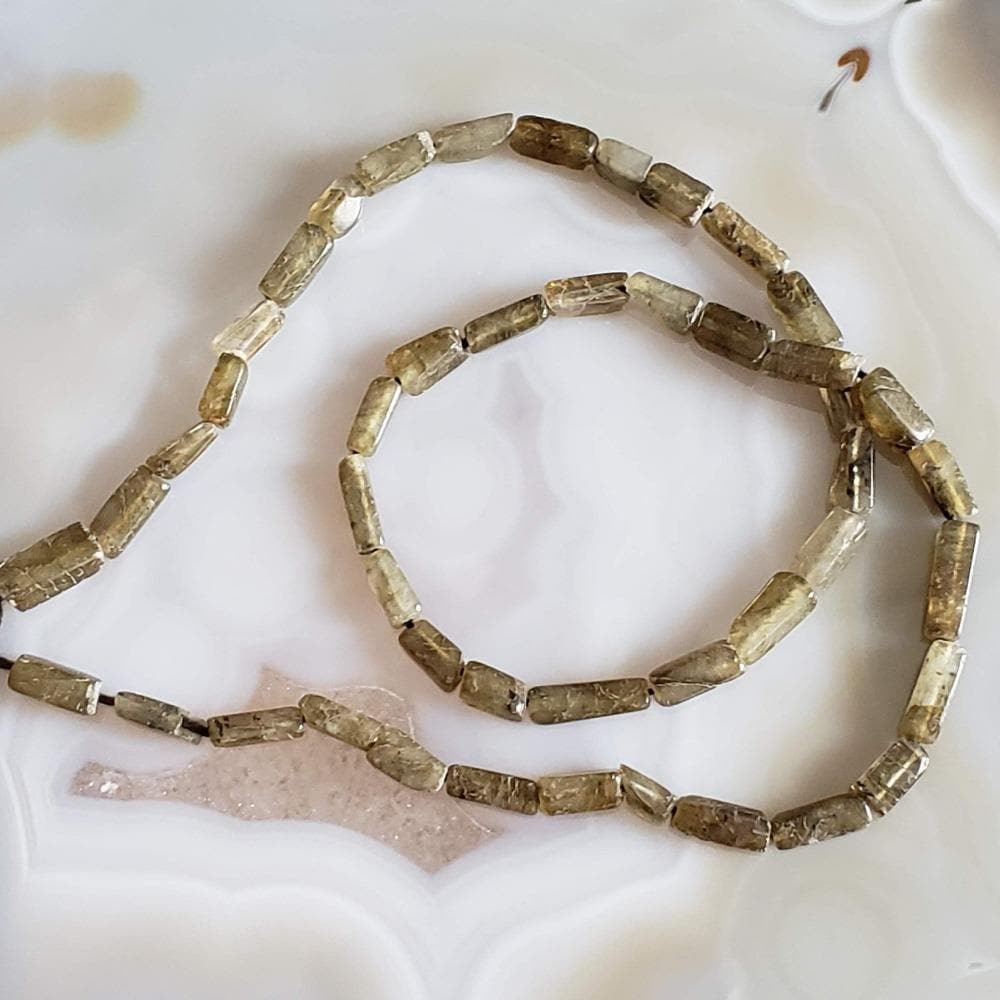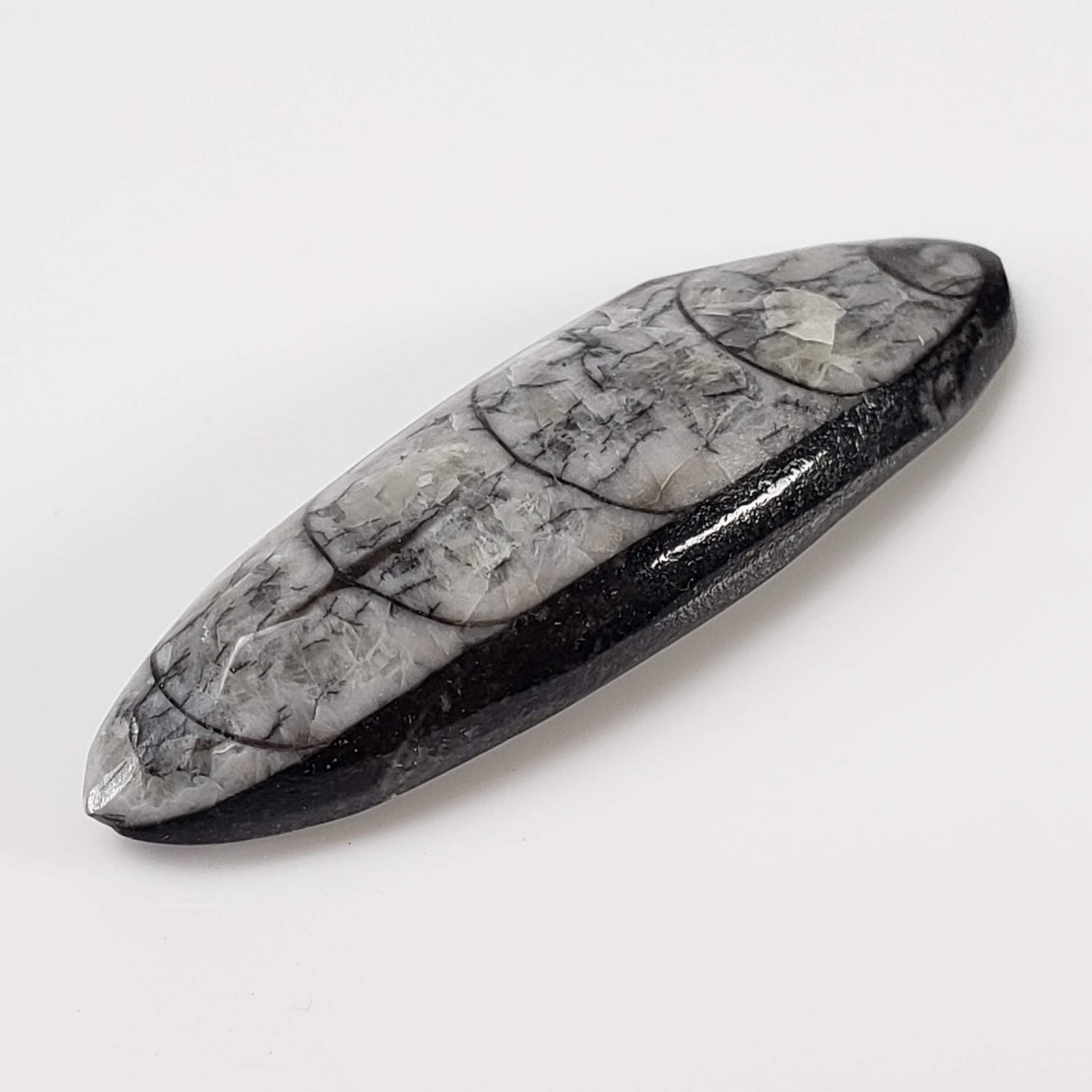Sort by:
98 products
98 products
These are fossilized, highly polished natural Ammonite in brown marble from Morocco Ammonites are perhaps the most widely known fossil, possessing the typically ribbed spiral-form shell. These creatures lived in the seas between 240 - 65 million years ago, and became extinct along with the dinosaurs. They belong to a group of predators known as cephalopods, which includes their living relatives the octopus, squid, cuttlefish and nautilus.
These specimens are great as teaching tools in the home or in the classroom, or as gifts. They can also be used for science projects and other types craft displays.
The dimensions of the Ammonites are as follows:
A. 67x59 mm / 106 gr | 2.6x2.3 in / 3.7 oz
B. 61x59 mm / 80 gr | 2.4x2.3 in / 2.8 oz
C. 60x59 mm / 74 gr | 2.4x2.3 in / 2.6 oz
D. 61x61 mm / 69 gr | 2.4x2.4 in / 2.4 oz
This is a strand of Labradorite beads with an overall length of 37 cm (14.5 inches). The individual gemstone beads are rectangular in shape and range in size from 9x3 to 11x4 mm. In total, the bead strand contains over 42ct of natural Labradorite beads.
Product Type: Labradorite Beads
Approx Weight (per Strand): 42.10 CT.
Bead Size: 9x3 to 11x4 mm
Strand Length: 37 cm / 14.5 inches
Shape: Rectangular
Color: Gray
This is a strand of Labradorite beads with an overall length of 36 cm (14 inches). The individual gemstone beads are rectangular in shape and range in size from 9x3 to 11x4 mm. In total, the bead strand contains over 52ct of natural Labradorite beads.
Product Type: Labradorite Beads
Approx Weight (per Strand): 52.6ct
Bead Size: 9x3 to 11x4 mm
Strand Length: 36 cm / 14 inches
Shape: Rectangular
Color: Gray
This is a lovely strand of multicolored natural agate beads with an overall length of 40 cm (15 inches). The individual beads are oblong in shape and range in size from 13x9 to 21x12 mm. In total, the bead strand contains over 307ct of natural agate beads.
Product Type: Agate Beads
Approx Weight (per Strand): 307.2ct
Bead Size: 13x9 to 21x12mm
Strand Length: 40 cm /15 inches
Shape: Oblong
Color: Multicolored


Eyebrow Barbell | Surgical Steel and 925 Silver | Tanzanite Crystal
Eyebrow Barbell | Surgical Steel and 925 Silver | Tanzanite Crystal
Product Type: Eyebrow jewelry
Product ID: SS0189
Gem Type: Tanzanite Crystal
Metal Type: Surgical Steel and Silver
Weight: Silver and crystal 3.15 Grams (0.55 Grams TW)
Number of Gems: 0 Piece(s), 0 CT
Size: 10 mm, 14 Gauge
Shape: Round Diamond Cut
Color: Top Pure Purple
Clarity: Clean
Origin: Hand made in Thailand


Eyebrow Barbell | Surgical Steel and 925 Silver | White Sapphire Crystal
Eyebrow Barbell | Surgical Steel and 925 Silver | White Sapphire Crystal
Product Type: Eyebrow jewelry
Product ID: SS0188
Gem Type: White Sapphire Crystal
Metal Type: Surgical Steel and Silver
Weight: Silver and crystal 3.15 Grams (0.55 Grams TW)
Number of Gems: 0 Piece(s), 0 CT
Size: 10 mm, 14 Gauge
Shape: Round diamond cut
Color: Intense Top Pure White
Clarity: Clean
Origin: Hand made in Thailand
Discover a remarkable Brachiopod fossil from the Fammenian stage of the Devonian period, sourced from the Kowala Formation in Poland’s Kielce-Lagow Syncline.
This natural specimen, measuring 16 mm and weighing approximately 2.21 grams, features exquisite pyritization within its host rock, offering valuable insight into ancient marine life and exceptional preservation for collectors and researchers alike.
Although dinosaurs are the most well-known fossil life forms, pyritized fossils are also a favorite among those familiar with Paleontology (the study of the development of life on Earth) and are found in the rocks of all continents.
Name: Brachiopod Fossil
Age: Fammenian (Devonian)
Location: Kowala Formation, Poland
Geological unit: Kielce-Lagow Syncline
Size: 2.21 gr / 0.08 oz
This is a lovely fossilized, and highly polished natural Orthoceras from Morocco. It measures 43x13 mm and weighs 6.1 grams. Orthoceras ("straight horn") is a genus of extinct cephalopod. This genus is sometimes called Orthoceratites. Note it is sometimes misspelled as Orthocera, Orthocerus or Orthoceros. Orthoceras are common fossils and have been found on many continents, including the Americas, Africa, Europe and Asia. They are dated to the lower Ordovician to Triassic ages (500 to 190 millions years ago). They belong to a group of predators known as cephalopods, which includes their living relatives the octopus, squid, cuttlefish and nautilus.
Orthoceras fossils are great as a collectors item or can be used for jewelry making.


Impactite Fallback Breccia | Steinheim Basin Impact Structure | 21.3 grams | Slice | Ries, Germany
$14.00 CAD
Unit price perImpactite Fallback Breccia | Steinheim Basin Impact Structure | 21.3 grams | Slice | Ries, Germany
$14.00 CAD
Unit price perThis is a fantastic Impactite Fallback Breccia from Germany weighing 21.3 grams and measuring 60x41x6mm. Although not a meteorite, impactites and shatter cones are directly linked to them and their impacts. The Steinheim Basin today exhibits a distinct morphological depression that is ∼110 m deep and ∼3.5 km in diameter; the height of the central uplift totals to more than 140 m. The original size of the pristine crater is estimated to be ∼3.8 km with an original depth of ∼205 m.
As this drainless morphological depression was filled by lake sediments shortly after the impact, the primary crater morphology is widely preserved. The crater rim is formed by steeply inclined and intensely brecciated Upper Jurassic limestone blocks that also contain numerous shattered chert nodules, as well as some loose blocks of the host limestone. An impact breccia, referred to as the so-called ”Primäre Beckenbrekzie” (“primary basin breccia”) and interpreted as a “fallback breccia”, is known from many drillings in the Steinheim Basin.
Mainly composed of Middle to Upper Jurassic limestones, marls, mudstones, and sandstones, the impact breccia inside the morphological depression of the Steinheim Basin is overlain by lake sediments and is obviously preserved in its original thickness and position. This piece displays very well and is a very nice size showing multiple characteristics of its origin. Would make a beautiful addition to any collection.
This is an individual Northwest Africa or NWA 4293 formerly known as NQ10, an H6 chondrite found in the Sahara desert in 2005. It is one of 5854 approved meteorites classified as such. The meteorite weighs 5.2 grams with dimensions of 25x16x10 mm.
This fascinating meteorite was mainly found as small individuals and the total weight of the 100's of pieces recovered is recorded as a low 25 kg. The meteorite has a shock stage of 4 and weathering grade of 2. NWA 4293 is interesting in the way it looks as can be seen in the images. Most pieces are free of caliche, have a smooth gray surface and are small complete individuals. The unusual appearance is due to shock hardening and being sandblasted in the desert.
This specimen comes with a Canagem specimen card. Would make a beautiful addition to any new or existing collection.
This is an individual Northwest Africa or NWA 4293 formerly known as NQ10, an H6 chondrite found in the Sahara desert in 2005. It is one of 5854 approved meteorites classified as such. The meteorite weighs 5.5 grams with dimensions of 22x18x9 mm.
This fascinating meteorite was mainly found as small individuals and the total weight of the 100's of pieces recovered is recorded as a low 25 kg. The meteorite has a shock stage of 4 and weathering grade of 2. NWA 4293 is interesting in the way it looks as can be seen in the images. Most pieces are free of caliche, have a smooth gray surface and are small complete individuals. The unusual appearance is due to shock hardening and being sandblasted in the desert.
This specimen comes with a Canagem specimen card. Would make a beautiful addition to any new or existing collection.
These are cabinet-sized Hourglass Selenite Crystals from Salt Plains, Oklahoma. Oklahoma designated the unique hourglass selenite crystal as the official state crystal in 2005 after elementary school students from Bryant and Red Oak School petitioned the state legislature. Hourglass selenite crystals are found only on the salt plains of Oklahoma, a unique 11,000-acre geological area. The salt plains were formed by repeated flooding by sea water millions of years ago.
Selenite (hydrous calcium sulfate) is a crystallized form of gypsum, a common mineral in sedimentary environments that can take on a great variety of crystal forms and shapes. Crystals take on the characteristics of their environment - iron oxide in the soil gives the hourglass crystals their chocolate brown color.
Hourglass Selenite is thought to amplify energies, aid in achieving balance and harmony, and align the crown chakra. Its protective qualities are believed to ward off negativity, and it is often used to enhance communication and promote emotional stability.
The weight and dimensions of the glass pieces are as follows:
B - 20.0gr / 71x31x10mm | 0.7oz / 2.8x1.2x0.4in
Prehnite can form prismatic, tabular, or pyramidal crystals, but usually occurs in botryoidal, reniform, stalactitic, granular, or compact habits. It is usually green in colour, but may be white, colourless, yellow, or gray. It has a colourless streak. Prehnite is transparent to translucent, with a vitreous to pearly luster. It forms in cavities in basaltic lavas.
Prehnite is said to be a stone of unconditional love and the crystal to heal the healer. Placing it in the garden is believed to help make a home into a healing sanctuary and teach one how to be in harmony with nature. A good Fung Shui stone, prehnite is said to be helpful for decluttering, helping one let go of possessions no longer needed.
Name: Prehnite Crystal Cluster
Specimen Size: Cabinet-Sized
Dimensions: 62x44x21 mm / 2.4x1.7x0.8 inches
Weight: 67 Grams / 2.4 Ounces
Origin: Mined in Mumbai (Bombay), India
You will receive the Labradorite stone of your choosing. These beautiful and unique stones originated in Madagascar.
Labradorite is an unusual mineral. It can display a beautiful iridescent play of colors, caused by internal fractures in the mineral that reflect light back and forth, dispersing it into different colors. This effect, known as labradorescence, gives Labradorite its appeal and fame.
This is a strand of clear crystal beads with an overall length of 37 cm (14.5 inches). The individual beads are faceted tube in shape and range in size from 8x5 to 9x5 mm. In total, the bead strand contains over 62ct of crystal beads.
Product Type: Crystal Beads
Approx Weight (per Strand): 62.6ct
Bead Size: 8x5 to 9x5 mm
Strand Length: 37 cm / 14.5 inches
Shape: Faceted Tube Shape
Color: Clear White
You will receive 1 Orthoceras cabochon. Each Orthoceras is beautiful and unique, variations in size, shape and color should be expected. Note the specimen shown in the photo represents a small selection of what we have in stock, the size, shape and color of the specimen we send will vary.
Here we have for you a nice fossilized highly polished natural Orthoceras from Morocco which is perfect for gift giving to a new fossil collector. Orthoceras ("straight horn") is a genus of extinct cephalopod. This genus is sometimes called Orthoceratites. Note it is sometimes misspelled as Orthocera, Orthocerus or Orthoceros. Orthoceras are common fossils and have been found on many continents,including the Americas, Africa, Europe and Asia. They are dated to the lower Ordovician to Triassic ages (500 to 190 millions years ago). They belong to a group of predators known as cephalopods, which includes their living relatives the octopus, squid, cuttlefish and nautilus.
These are priced as an entry level fossil. This item has been listed in bulk with pictures providing a great example of what you will receive. Sizes varies between 30 to 55 mm long by 10 to 30 mm wide.
These fossils would be excellent for jewelry making.




























